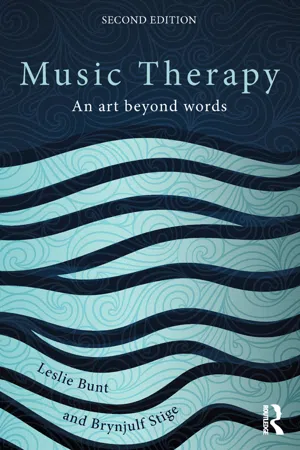
- 256 pages
- English
- ePUB (mobile friendly)
- Available on iOS & Android
About this book
Music therapy is recognised as being applicable to a wide range of healthcare and social contexts. Since the first edition of Music Therapy: An art beyond words, it has extended into areas of general medicine, mainstream education and community practice. This new edition revises the historical and theoretical perspectives and recognises the growing evidence and research base in contemporary music therapy.
Leslie Bunt and Brynjulf Stige document the historical evolution of music therapy and place the practice within seven current perspectives: medical, behavioural, psychoanalytical, humanistic, transpersonal, culture-centred and music-centred. No single perspective, individual or group approach is privileged, although the focus on the use of sounds and music within therapeutic relationships remains central. Four chapters relate to areas of contemporary practice across different stages of the lifespan: child health, adolescent health, adult health and older adult health. All include case narratives and detailed examples underpinned by selected theoretical and research perspectives. The final two chapters of the book reflect on the evolution of the profession as a community resource and the emergence of music therapy as an academic discipline in its own right.
A concise introduction to the current practice of music therapy around the world, Music Therapy: An art beyond words is an invaluable resource for professionals in music therapy and music education, those working in the psychological therapies, social work and other caring professions, and students at all levels.
Frequently asked questions
- Essential is ideal for learners and professionals who enjoy exploring a wide range of subjects. Access the Essential Library with 800,000+ trusted titles and best-sellers across business, personal growth, and the humanities. Includes unlimited reading time and Standard Read Aloud voice.
- Complete: Perfect for advanced learners and researchers needing full, unrestricted access. Unlock 1.4M+ books across hundreds of subjects, including academic and specialized titles. The Complete Plan also includes advanced features like Premium Read Aloud and Research Assistant.
Please note we cannot support devices running on iOS 13 and Android 7 or earlier. Learn more about using the app.
Information
1 The growth of music therapy
Introduction
The emergence of music therapy in the United Kingdom and the United States
- 1944: Michigan State University: first curriculum established;
- 1945: National Music Council formed a music therapy committee;
- 1946: Kansas University: first full academic course taught;
- 1950: National Association of Music Therapy (NAMT) formed;
- 1971: American Association of Music Therapy (AAMT) formed.11
- 1958: Society for Music Therapy and Remedial Music formed by Alvin and renamed the British Society for Music Therapy (BSMT) in 1967;
- 1968: Guildhall School of Music and Drama, London: first full-time postgraduate course taught by Alvin;17
- 1974: Goldie Leigh Hospital, south London: first course taught by Nordoff and Robbins;18
- 1976: Association of Professional Music Therapists (APMT) formed, with Angela Fenwick as the first chair.19
Table of contents
- Cover Page
- Half-Title Page
- Title Page
- Copyright Page
- Table Of Contents
- Acknowledgements
- Introduction: formation and form
- 1 The growth of music therapy
- 2 Music therapy examples and perspectives
- 3 Sound, music and music therapy
- 4 Music therapy and child health
- 5 Music therapy and adolescent health
- 6 Music therapy and adult health
- 7 Music therapy and older adult health
- 8 The profession of music therapy: a resource for the community
- 9 The discipline of music therapy: towards an identity of hybridity?
- Epilogue: music therapy: an art beyond words?
- References
- Name index
- Subject index